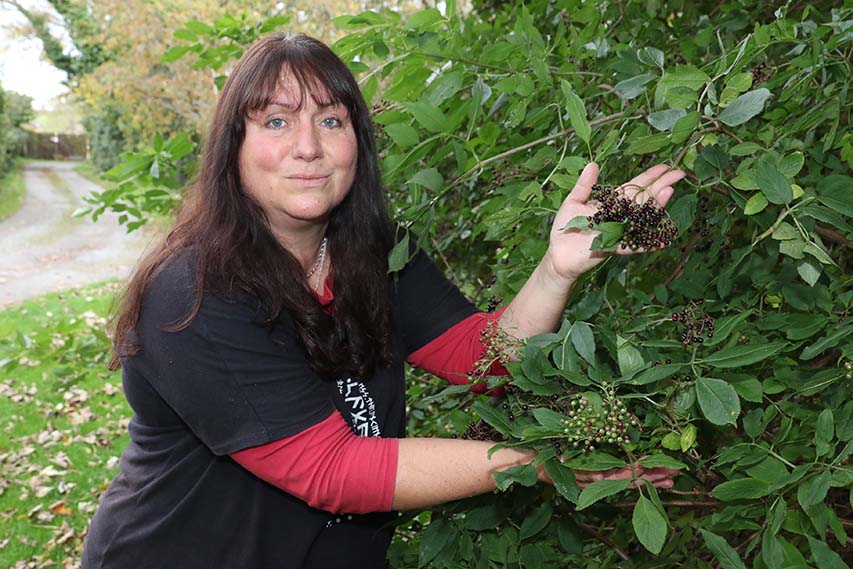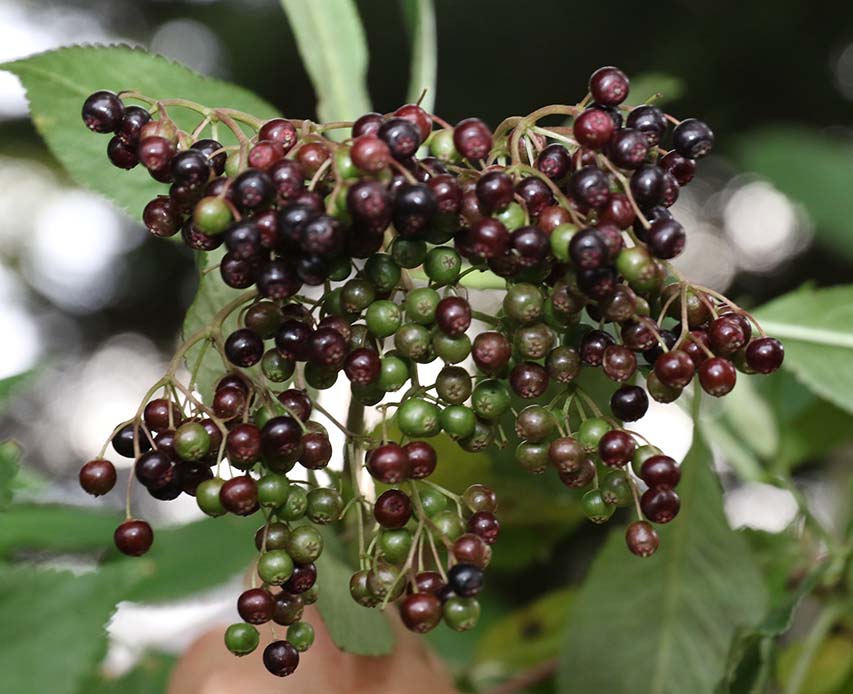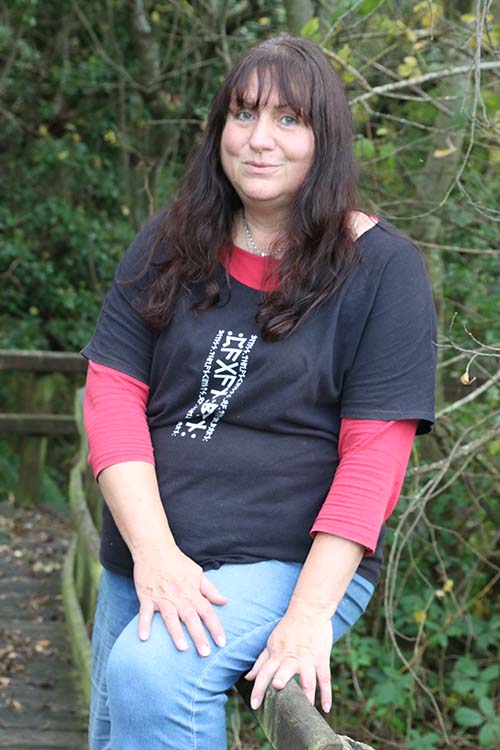Foraging in the countryside is a fascinating interest and expert forager Alison McGrenaghan talks to Down News about the seasonal bounties this month that lie all around us.
Helen Hastings, Down News writer, chats to Alison McGrenaghan about the benefits and pleasures of Autumn foraging.
Helen writes, can you believe that autumn is here already? It seems that this year has flown by in a whirlwind of uncertainty. I remember thinking that March would never end.
We were all just living our lives as normal, making plans and looking forward to the summer and in the next beat of our hearts, we were battling a deadly virus! In the last year I think most of us have struggled to feel at home in our normally safe lives, everything has looked and felt different on so many levels.

One thing that has helped us feel and stay connected was the nostalgic sense of love that we find in food. As the autumn sweeps us up into her chilly and increasingly dark embrace, we find memories in the hedgerows.
Blackberries, sloe berries and rose hips provide sweet indulgence that makes our goodbyes to the summer a little less harsh. One thing guaranteed to make me smile, is the tell-tale purple smudge on fellow dog walkers mouths.
They too have succumbed to the heady sense of nostalgia that the shiny blackberries instil in all of us. It’s a sense, that as uncertain and frightening this year has been, we can always count on nature and the changing of the seasons to bring us back home to ourselves.
In this edition of Wild Food and Foraging, I chatted to our expert Alison McGrenaghan on the joys of autumn foraging and the winter warmth of hedgerow berries.
Disclaimer: Helen Hastings and Alison McGrenaghan are not liable for any damage or disorderly conduct following the irresponsible drinking of sloe gin !! Following a drunken disaster involving plum wine, both Alison and Helen have since amended their public liability insurance!
Well Alison, here we are, autumn once again! I know that like me, the autumn is one of your favourite times of the year. Can you share with us, your own personal reasons as to why it is such a magical time?
We’re back to that lovely rushing energy that comes between the equinox to the solstice. Once the solstice is past, the energy seems to flatten out and things just don’t feel the same. Now, however, we can enjoy the crisp energy of transmutation, as the seasons merge into the darker half of the year.
I love the fact that temperatures are cooling and morning and evenings both have a pleasant fresh feel to them. Also as the air cools and the sky remains dark for longer, the night skies become clearer and you can really enjoy the constellations.
There are few sights more beautiful than a cold, crisp, star-spangled night. So light up those candles, build up the fire in your hearths and enjoy!
I was lucky this season to secure some sloes for that intoxicating festive treat, sloe gin! However, sloes and plums share a frustrating bi-annual fruiting nature; can you shed some light on this?

Different sources give different advice on this subject. If you are growing trees that fruit every other year, the general advice seems to be that they are not getting sufficient nutrients to manage to produce every year, hence the bi-annual fruiting pattern.
The idea is that you would then feed the trees and do everything that you could to create ideal conditions for them, in order to enable them to fruit annually.
However, wild plants don’t necessarily enjoy these options, so bi-annual it is for many of them. Personally I am of the opinion that if a tree is naturally fruiting bi-annually and seems to be generally happy and in good health, well then just let it be.
Mother nature’s ideas of appropriate food production and ours isn’t always the same thing. However, because we know this can be the case, it is a good idea to have several foraging sites that you use, meaning that if one of your sites is “resting” you can usually harvest one of the others.
Most people will be familiar with blackberries but some other autumn fruits will be new to them, can you give a brief guide on how to identify the edible varieties of berries on show this year?
A good rule of thumb is to keep an eye on potential plants all year round. If you have observed a tree or bush in leaf and flower, then you will probably have a better ability to identify it when it bares its fruit. As ever, when in doubt don’t! Some useful and tasty plants to look for this time of year are:-
Blackberries – no real introduction needed here, as their name suggests they are deep purple, almost to the point of being black. They are known for their bobbly shape and their scrumptious, sweet flavour. Technically they are not really a berry, but rather an aggregate fruit composed of individual drupes bound together by fine hairs.
Elderberries – These grow on small trees. In the spring they bear large clusters of small lacy, white or cream-coloured flowers , these are followed in the late summer and early Autumn by clusters of small, blue-black berries.
Sloes – These also grow on small trees, large bushes and in hedgerows. The branches of this shrub have long sharp spiny thorns. As it has been heavily planted as hedgerows, it is widely available. Like all the plum family, sloe berries have pruinosity, this is a white powdery dusting on the skin.
The warning with sloes is that you might encounter similar looking berries, which are not sloes!
Common buckthorn looks a little like sloe, but they do not have pruinosity and the ripe berries should be a bit darker, and more clustered than sloe. These berries are mildly toxic, they won’t be fatal, but you might have a bit of an upset stomach. Although to be fair, it is the rarest tree in Northern Ireland.
Damsons – These are relatively small, deep blue-purple, ovoid plum-like fruit. They grow on small to medium sized trees. They ripen late summer,into early Autumn.
Rosehips – Also sometimes called rose haws. These are typically red to orange, but in some species the colours can become as dark as purple and black. Rose hips grow on thorned briars and begin to ripen in late summer through autumn.
Crabapples –Small, hard apples ranging from yellow to red in colour. These grow on small trees in hedgerows and are ready to harvest early in the Autumn. They are unpalatable raw but good once cooked, or processed.
Alison, you and I are both sloe gin lovers but some people will be unfamiliar with the concept, so can you give a description of this magical elixir and explain why it’s so wonderful?
Well, it’s a classic winter warmer isn’t it. When the nights are dark and the weather is cold and the candles lit, a glass of sloe gin really completes the picture.
The sloes, which if bitten into when fresh, are bitter and unpleasant, become deeply flavoursome once they have been steeped in gin with some other well chosen ingredients. Personally I like to add some winter spices too.
And while we’re on the subject of magical elixirs, can you tell us about the healing properties of elderberries.
Ah! I am glad you asked. I am a big fan of the healing properties of elderberry.
There are many reported benefits of elderberries and although there have been scientific investigations undertaken, there is still work to be done in this field. They are undoubtedly nutritious, but there have also been promising results showing that they may fight cold and flu symptoms, support heart health and fight inflammation and infections.
They have been shown in some studies to reduce the severity and length of influenza. Elderberry may also have some benefits for heart health, such as reducing cholesterol, uric acid and blood sugar levels. However, again further research is needed to demonstrate if these effects are significant.
In separate investigations, both European and American elder has been found to have some cancer-inhibiting properties in test-tube studies.
It is believed to support the immune system and in experiments carried out on rats, elderberry polyphenols were indeed found to be effective in the support of immune defence by increasing the number of white blood cells.
On the other hand, it is important to remember that bark, unripe berries and seeds contain small amounts of substances known as lectins , which can be toxic and these can cause stomach problems if too much is eaten.
Winter foraging is always my favourite as I love the crisp cold air and that wonderful ‘glow’ feeling from being out in the damp coolness, but like with everything, there is always a health and safety element. Can you outline any dangers that lurk beyond the hot summer months?
Well, weather for starters. Always wear suitable clothing and footwear. Layered clothing with a waterproof outer layer, allows you to adapt to changing weather conditions, which is useful. Also wellies or walking boots with a good grip. The ground can be wet and slippery! Over reaching on a slippery surface can also end in disaster, so a long hooked stick can come in useful here.
Many berried plants, such as blackthorn and briar rose are thorney too, so gardening gloves can be useful to avoid being scratched and spiked.
Alison, can you describe your dream autumn banqueting table?
Mmmm, in a sentence, warm, spicy and delicious! I love the flavours of Autumn. I also love combining fruits with savoury dishes and in chutneys, all of which lend themselves to food at this time of year. I guess I would choose some of the following:-

Creamy Pumpkin Soup
Blackberry, Goat’s Cheese and Spinach Pizza
Apple, Walnut and Blue Cheese Coleslaw
Berry Glazed Wild Salmon
Nut and Mushroom Roast
Venison Sausages with Maple Glazed Crabapples
Cheese and Apple Chutney
Rhubarb and Ginger Cheesecake
Spiced Pear Cake
Blackberry ice cream
And what are your favourite recipes for autumn wild food?
Crabapple Jelly:
Ingredients
4 kg crab apples
1 kg caster sugar
1 lemon, juiced
2 cinnamon sticks
Cloves
Root ginger, peeled and roughly chopped
Makes 6 x 500ml jars – or use these proportions.
Method
1) Wash the apples, removing any bruised fruit. Put in a saucepan, fill with water to just cover
the apples.
2) Bring to the boil and simmer until the fruit is soft (about 30 minutes).
3) Pour the pulp into a jelly bag or several layers of muslin and let drip overnight into a pan.
Do NOT squeeze the bag or it will make the juice cloudy.
4) The next day, measure the juice, and add sugar in the ratio of 10 parts juice to 7 of sugar.
Add some lemon juice, then bring to the boil, stirring to dissolve the sugar.
5) Add the spices.
6) Keep at a rolling boil for 40 minutes, skimming off the froth. To test the set, chill a dessertspoon in the refrigerator.
7) When the jelly is set, it will solidify on the back of the spoon. Scoop out the spices. Pour into warm, sterilised preserving jars and tightly seal while still slightly warm. Store in a cool dark place.
Sloe Gin.
Ingredients
500g ripe sloes
250g soft dark brown sugar
2 cinnamon sticks
5 cloves
A piece of root ginger, peeled and roughly chopped
1 litre gin
Method:
1) Rinse and pick over the sloes, then pat dry in a clean tea towel. Using a stainless steel fork or cocktail stick, prick the sloes and tip into a 2-litre glass jar, or divide between two smaller jars.
2 ) Add the sugar, spices and gin, then seal the jar. Shake well. Once a day for seven days, give the jar a good shake. Store the jar in a cool, dark place and leave for two to three months.
3) Line a plastic sieve with a square of muslin set over a bowl and strain the sloe gin through it.
4) Decant into clean, dry bottles, then seal and label. The sloe gin is now ready to drink but it’ll improve and mature over time – so, if possible, make it one year to drink the next.
We are heading into what’s probably going to feel like a very strange festive season. How does cooking and your relationship with nature (foraging included) help you stay grounded?
Yes, it’s beginning to look that way isn’t it. I think nature and natural processes always make you feel grounded. Animals and children will do this as they live very intensely and completely honestly in the moment. Getting out into nature once a day is key to retaining one’s equilibrium when under pressure.
Every parent out there knows that getting the kids out into nature once a day, can be the difference between making it through successfully or not! My good friend Robert Henry swore by sitting with your back against the trunk of a large old tree, he maintained that the energy of it would ground you, clear your mind and lift your spirits.
I have to say that I feel the human race have a symbiotic relationship with trees, albeit one that not everyone chooses to acknowledge.
Personally speaking, nature is carrying me through. I am lucky enough to both live and work in the countryside, which I think from a practical point of view has really shielded me from the worst of the restrictions.
Also there is something comforting about the fact that plants existed long before the human race and if we were all wiped out tomorrow, they would continue, there would still be life. I have been busy harvesting elderberries and I have been making tincture for flu and upper respiratory conditions.
Doing an activity like this helps to make you feel as though you are “standing in your own power,” and it certainly helps me feel a little more in control in this mad world.
All of the above said, I am still looking forward to the festivals Samhain and Yuletide. Not in the swinging party sense of things, but with the promise of small, intimate celebrations within the household.
I have a small stack of pumpkins ready to carve and cook. Sadly my own pumpkin patch didn’t deliver this year, so it is all thanks to Lidl * guess.
I am already busy making jams and chutneys for Yule hampers, everyone is getting small homemade gifts from me this year.
I guess it’s about making the best of things wherever we find ourselves.
























